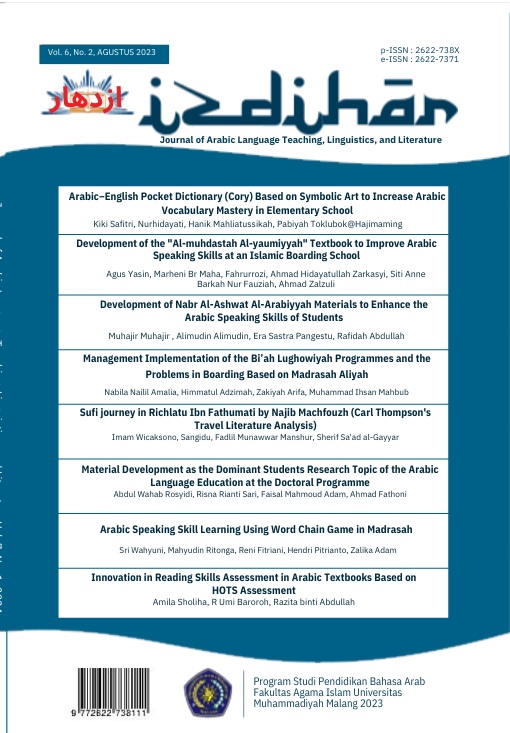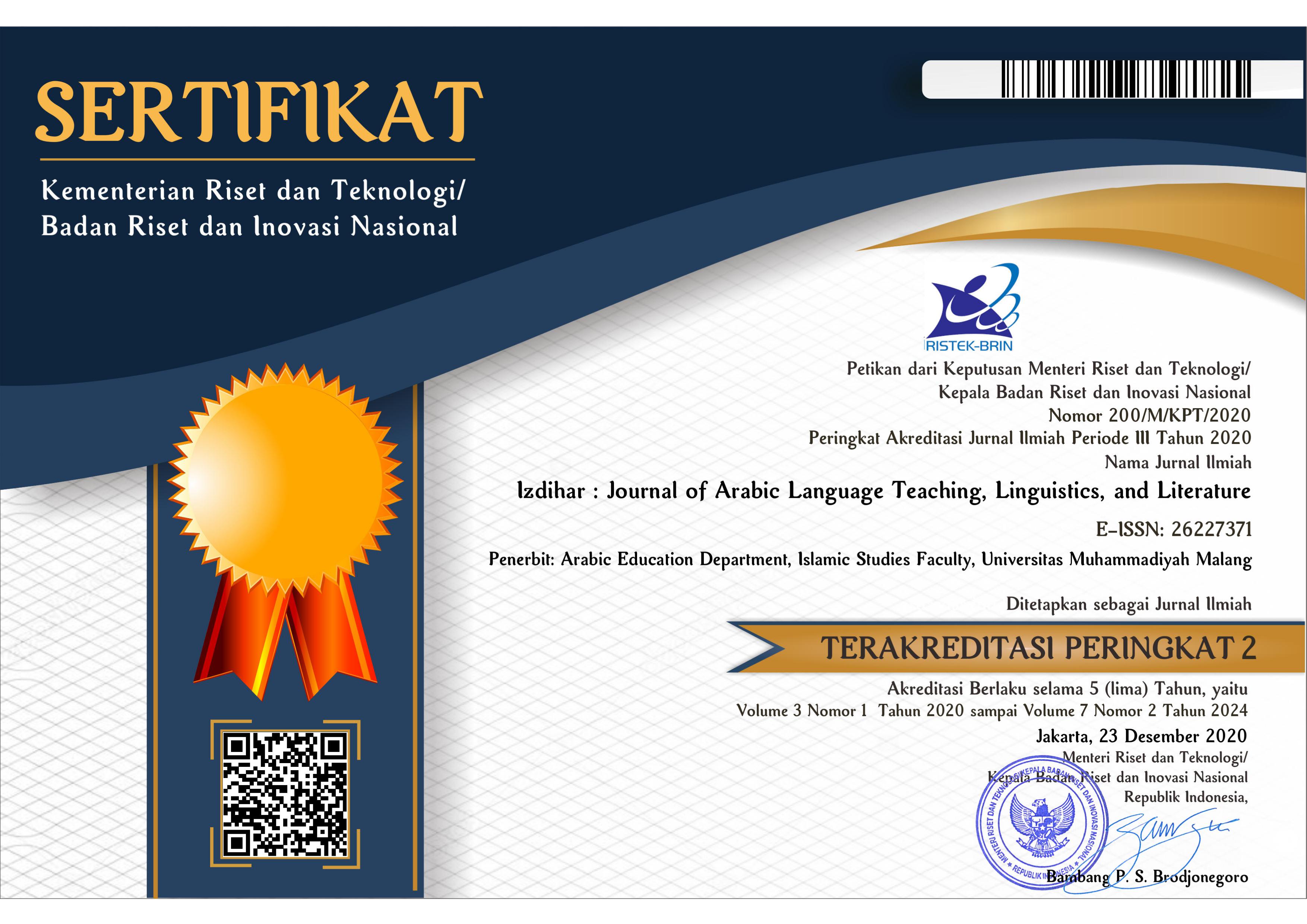Arabic Speaking Skill Learning Using Word Chain Game in Madrasah
DOI:
https://doi.org/10.22219/jiz.v6i2.28192Keywords:
Language Game, Word Chain, maharah al-kalamAbstract
This study aimed to reveal the use of word-chain games as a strategy in teaching Arabic spaking skill (maharah al-kalam) . This study used a qualitative approach where data were collected through observation, interviews, and documentation studies. The qualitative analysis methodologies of Miles and Huberman were used for this study. Qualitative analysis consists of three steps after data collection: data condensation, data presentation, and conclusion drawing or verification. Based on the results, maharah al-kalam learning using word chain games has an impact on the quality of the process, as evidenced by increased results. Students become more active, and their motivation increases. Improving the quality of the learning process is evidenced by the active participation of students in responding to teacher statements as well as their enthusiasm in perfecting sentences spoken by other groups. Learning outcomes are getting better, but fluency and memorization of vocabulary cannot be improved using the word chain game. According to observers and practitioners of Arabic language education, word chains have an impact on teaching speaking skills; therefore, it is important to explain their use in Ilamic Junior High School (Madrasah Tsanawiyah).
Downloads
References
Adansia, J. E., & Oringo’s, J. O. (2022). Language Games and Acquisition of Speaking Skills among Students of Junior High School in Hohoe Municipality, Ghana. American Scientific Research Journal for Engineering, Technology, and Sciences (ASRJETS), 61(1), 61–74. https://asrjetsjournal.org/index.php/American_Scientific_Journal/article/view/5216
Adhabi, E., & Anozie, C. B. (2017). Literature Review for the Type of Interview in Qualitative Research. International Journal of Education, 9(3), 86–97. https://doi.org/10.5296/ije.v9i3.11483
al Huneety, A., Mashaqba, B., abu Hula, R., & Thnaibat, B. K. (2021). Phonological aspects of al-Issa Arabic, a Bedouin dialect in the north of Jordan. Heliyon, 7(7), e07405. https://doi.org/10.1016/j.heliyon.2021.e07405
Albantani, A. M., & Madkur, A. (2019). Teaching Arabic in the era of Industrial Revolution 4.0 in Indonesia: Challenges and opportunities. ASEAN Journal of Community Engagement, 3(2), 197–213. https://doi.org/10.7454/ajce.v3i2.1063
Aljojo, N., Munshi, A., Almukadi, W., Zainol, A., Alanaya, I., Albalawi, H., Alharbi, G., Almadani, N., Almohammadi, E., Kadu, A., & Abdulghaffar, N. A. (2019). The design and implementation of an arabic pronunciation application for early childhood. Journal of Technology and Science Education, 9(2), 136–152. https://doi.org/10.3926/jotse.486
Amin, I., Ritonga, M., Sobhan, S., & Kumar, T. (2022). Implementation of Activity-Based Language Week Program in Improving Arabic Communication Skills at Ma’had al-Jami’ah. Izdihar : Journal of Arabic Language Teaching, Linguistics, and Literature, 5(1), 45–58. https://doi.org/10.22219/jiz.v5i1.19911
Ansyah, S., Ritonga, M., & Alrasi, F. (2020). Sistem Kaji Duduak Sebagai Strategi Pembelajaran Maharah Al-Qira’Ah Di Madrasah Batang Kabung. Arabi : Journal of Arabic Studies, 5(2), 191. https://doi.org/10.24865/ajas.v5i2.257
Aprianto, A., Ritonga, M., Marlius, Y., & Nusyur, R. (2020). The Influence of Using Audio-lingual Method on Students’ Speaking Skill in Madrasah Diniyah Takmiliyah Awwaliyyah. Izdihar : Journal of Arabic Language Teaching, Linguistics, and Literature, 3(2), 147–160. https://doi.org/10.22219/jiz.v3i2.12514
Armstrong, G. A. (1999). Quantitative Descriptive Analysis (QDA) - utilising the human instrument. Nutrition & Food Science, 99(6). https://doi.org/10.1108/nfs.1999.01799faf.001
As-Sammer, M. A. A. S. (2010). Phonological Variation in Modern Standard Arabic: The Case of The Affricate/ʤ: Oman As a Sample. Journal of Basra Researches for Human Sciences, 36(4), 29–57. https://www.iasj.net/iasj/download/fdb9bf9817f65956
Bahang, M. D. (2022). Improving Students Vocabulary Mastery by Using Fly Swatter Game at The Seventh Grade Students of SMPN 2 Kulo. The Educational Review, USA, 6(8), 341–345. https://doi.org/10.26855/er.2022.08.003
Baker, L. M. (2006). Observation: A complex research method. Library Trends, 55(1), 171–189. https://doi.org/10.1353/lib.2006.0045
Bariyah, K., & Muassomah, M. (2019). Metode Ta’Bir Ash-Shuwar Al-‘Asywai: Inovasi Pembelajaran Maharah Kalam Mahasiswa Pendidikan Bahasa Arab IAIN Madura. Alfazuna: Jurnal Pembelajaran Bahasa Arab Dan Kebahasaaraban, 4(1), 1–34. https://doi.org/10.15642/alfazuna.v4i1.509
Baroroh, R. U., Shodik, M. J., & Fransiska, T. (2016). Peningkatan Pembelajaran Bahasa Arab Melalui Indeks Kata Dan Frasa Dalam Bahan Ajar Di Madrasah Ibtidaiyah Non Pesantren. Arabi : Journal of Arabic Studies, 1(2), 24–33. https://doi.org/10.24865/ajas.v1i2.6
bin Samah, R., Puteh-Behak, F., Mat Saad, N. S., Mohd Ali, S., Darmi, R., & Harun, H. (2016). Effective Methods in Learning Arabic Language as a Foreign Language. Mediterranean Journal of Social Sciences, 7(3), 349–355. https://doi.org/10.5901/mjss.2016.v7n3p349
Casañpitarch, R. (2018). An approach to digital game-based learning: Video-games principles and applications in foreign language learning. Journal of Language Teaching and Research, 9(6), 1147–1159. https://doi.org/10.17507/jltr.0906.04
Chapman, K. W., Lawless, H. T., & Boor, K. J. (2001). Quantitative Descriptive Analysis and Principal Component Analysis for Sensory Characterization of Ultrapasteurized Milk. Journal of Dairy Science, 84(1), 12–20. https://doi.org/https://doi.org/10.3168/jds.S0022-0302(01)74446-3
Chen, H.-J. H., & Hsu, H.-L. (2020). The impact of a serious game on vocabulary and content learning. Computer Assisted Language Learning, 33(7), 811–832. https://doi.org/10.1080/09588221.2019.1593197
Derakhshan, A., & Davoodi Khatir, E. (2015). The Effects of Using Games on English Vocabulary Learning. Journal of Applied Linguistics and Language Research, 2(3), 39–47. https://www.jallr.com/index.php/JALLR/article/view/40
Dickinson, T. M. (2019). God knows: acquaintance and the nature of divine knowledge. Religious Studies, 55(1), 1–16. https://doi.org/10.1017/S0034412517000324
El-Tingari, S. M. (2016). Strategies for Learning Second Language Skills: Arabic Speaking Skills in the Malaysian Context. International Journal of English Language Teaching and Linguistics, 1(1), 19–34.
Fattah, M., Setiawan, A., Abusyairi, K., Rusdi, Sayuri, & Anhar, M. (2022). Quality of Arabic Learning in Traditional Islamic Boarding Schools and Modern Islamic Boarding Schools. Italienisch, 12(2), 505–517. https://www.italienisch.nl/index.php/VerlagSauerlander/article/view/366
Fithriani, R. (2021). The utilization of mobile-assisted gamification for vocabulary learning: Its efficacy and perceived benefits. Call-Ej, 22(3), 146–163. http://callej.org/archives.html
Haleem, A., Javaid, M., Qadri, M. A., & Suman, R. (2022). Understanding the role of digital technologies in education: A review. Sustainable Operations and Computers, 3(February), 275–285. https://doi.org/10.1016/j.susoc.2022.05.004
Huda, M., Yusuf, J. Bin, Azmi Jasmi, K., & Nasir Zakaria, G. (2016). Al-Zarnūjī’s Concept of Knowledge (‘Ilm). SAGE Open, 6(3), 1–13. https://doi.org/10.1177/2158244016666885
Ibrahim, A. (2017). Advantages of Using Language Games in Teaching English as a Foreign Language in Sudan Basic Schools. American Scientific Research Journal for Engineering, Technology, and Sciences (ASRJETS), 37(1), 140–150. Retrieved from https://asrjetsjournal.org/index.php/American_Scientific_Journal/article/view/3508
Ilhami, Z., & Robbani, A. S. (2021). Arabic language learning in a comprehensive approach (theoretical study). Ekspose: Jurnal Penelitian …, 20(2), 1240–1249. https://doi.org/10.30863/ekspose.v20i2.1391
Ilomäki, L., & Lakkala, M. (2019). Digital technology and practices for school improvement: innovative digital school model. Research and Practice in Technology Enhanced Learning, 13(25), 1–32. https://doi.org/https://doi.org/10.1186/s41039-018-0094-8
Insani, M., Hamdani, W. H., & Sopian, A. (2021). Upaya Peningkatan Maharah Kalam Melalui Kegiatan Intrakurikuler Muhadharah. An Nabighoh: Jurnal Pendidikan Dan Pembelajaran Bahasa Arab, 23(1), 51–66. https://doi.org/10.32332/an-nabighoh.v23i1.2281
Kaur, D., & Abdul Aziz, A. (2020). The Use of Language Game in Enhancing Students’ Speaking Skills. International Journal of Academic Research in Business and Social Sciences, 10(12), 687–706. https://doi.org/10.6007/ijarbss/v10-i12/8369
Khaira, M. (2021). The Effectiveness of Crossword Puzzle in Improving Mufradat Skills. Tanwir Arabiyyah: Arabic As Foreign Language Journal, 1(2), 55–62. https://doi.org/10.31869/aflj.v1i2.2864
Khan, R., Radzuan, N., Shahbaz, M., Ibrahim, A., & Mustafa, G. (2018). The Role of Vocabulary Knowledge in Speaking Development of Saudi EFL Learners. Arab World English Journal, 9(1), 406–418. https://doi.org/10.24093/awej/vol9no1.28
Lubis, A. A., Yunaldi, Y., & Yunita, F. S. (2021). the Use of Language Games To Increase Motivation in Learning Istimâ’. Arabiyat : Jurnal Pendidikan Bahasa Arab Dan Kebahasaaraban, 8(2), 228–240. https://doi.org/10.15408/a.v8i2.22533
Madya, S., & Meiningsih, F. A. (2021). The Use of Guessing Game in Improving the Speaking Skills of Elementary School Students. IJEE (Indonesian Journal of English Education), 8(2), 327–339. https://doi.org/10.15408/ijee.v8i2.21679
Mardiah. (2015). Metode Permainan Dalam Pembelajaran Bahasa Indonesia Di Madrasah Ibtidaiyah. MITRA PGMI: Jurnal Kependidikan MI, 1(1), 61–77. https://doi.org/10.46963/mpgmi.v1i1.33
Marlius, Y., Bambang, B., & Wirman, M. (2021). The Efforts to Improve Students’ Arabic Speaking Skills Through Language Environment Activation: A Study of Phenomenology. Al-Ta’rib : Jurnal Ilmiah Program Studi Pendidikan Bahasa Arab IAIN Palangka Raya, 9(1), 35–48. https://doi.org/10.23971/altarib.v9i1.2585
Masrukhin. (2020). Bahasa Arab MTs Kelas VIII (M. W. Dariyadi (ed.)). Direktorat KSKK Madrasah Direktorat Jenderal Pendidikan Islam Kementerian Agama RI.
Mat, A. C., Bakar, A. F. A., Nokman, A. Z., Musilehat, N. S., & Mohamad, N. (2020). Speaking Skills: What Arabic Language Students Do in Simulation Activity? Universal Journal of Educational Research, 8(12), 6998–7005. https://doi.org/10.13189/ujer.2020.081267
Maulani, S. (2021). The Use of Chain Word Game as Vocabulary Building Activity in Vocational High School. International Journal of Learning and Teaching, 7(4), 244–247. https://doi.org/10.18178/ijlt.7.4.244-247
Miftah, I., Saefuloh, H., Aedi, K., & Wahyudin, W. (2020). Pengaruh permainan bahasa terhadap peningkatan penguasaan mufrodat siswa kelas VII MTs Tarbiyatul Muta’alimin Pasawahan. El-Ibtikar, 9(2), 183–207. https://doi.org/10.24235/ibtikar.v9i2.7233
Miles, M. B., Huberman, A. M., & Saldana, J. (2014). Qualitative Data Analysis, A Methods Sourcebook. In Qualitative Data Analysis, A Methods Sourcebook, Edition 3 (pp. 107–119). https://doi.org/10.7748/ns.30.25.33.s40
Mitchell, K. M. W., & Manzo, W. R. (2018). The Purpose and Perception of Learning Objectives. Journal of Political Science Education, 14(4), 456–472. https://doi.org/10.1080/15512169.2018.1433542
Mohammed, T. (2022). Designing an Arabic Speaking and Listening Skills E-Course: Resources, Activities and Students’ Perceptions. Electronic Journal of E-Learning, 20(1), 53–68. https://doi.org/10.34190/ejel.20.1.2177
Novi Rina Dewi, & Alfany Fardan Syahuma. (2022). An Analysis of Students’ Vocabulary Mastery by Using Word Chain Game at Basic Level of AVON English School Kepung Pare. ETJaR: English Teaching Journal and Research, 2(1), 81–112. https://doi.org/10.55148/etjar.v2i1.287
Philipps, A., & Mrowczynski, R. (2021). Getting more out of interviews. Understanding interviewees’ accounts in relation to their frames of orientation. Qualitative Research, 21(1), 59–75. https://doi.org/10.1177/1468794119867548
Puteri, L. H. (2018). The Apperception Approach for Stimulating Student Learning Motivation. International Journal of Education, Training and Learning, 2(1), 7–12. https://doi.org/10.33094/6.2017.2018.21.7.12
Ritonga, M., Febriani, S. R., Kustati, M., Khaef, E., Ritonga, A. W., & Yasmar, R. (2022). Duolingo : An Arabic Speaking Skills’ Learning Platform for Andragogy Education. Education Research International, 2022, 7090752. https://doi.org/10.1155/2022/7090752
Ritonga, M., Sobhan, Bambang, & Khadidja, S. (2022). Utilizing Technology to Improve the Quality of Learning in Indonesia : Challenges and Consequences for Arabic Teachers Arabiyât. Arabiyat : Jurnal Pendidikan Bahasa Arab Dan Kebahasaaraban, 9(1), 56–68. https://doi.org/10.15408/a.v9i1.24516
Ritonga, M., Zulmuqim, Z., Bambang, B., Kurniawan, R., & Pahri, P. (2022). SIAKAD machine learning for correcting errors in speaking Arabic. World Journal on Educational Technology : Current Issues, 14(3), 768–780. https://doi.org/https://doi.org/10.18844/wjet.v14i3.7214
Rosid, A., Hasanah, M., & Yurisa, P. R. (2021). Online Model Of Teaching Arabic Speaking Skill In State Islamic Universities. Ijaz Arabi Journal of Arabic Learning, 4(3), 668–679. https://doi.org/10.18860/ijazarabi.v4i3.9202
Simons, P. R.-J., & Ruijters, M. C. P. (2008). Varieties of work related learning. International Journal of Educational Research, 47(4), 241–251. https://doi.org/10.1016/j.ijer.2008.07.001
Su, F., Zou, D., Xie, H., & Wang, F. L. (2021). A Comparative Review of Mobile and Non-Mobile Games for Language Learning. SAGE Open, 11(4), 1–20. https://doi.org/10.1177/21582440211067247
Sueraya Che Haron, Ismail Syeikh Ahmad, Arifin Mamat, & Ismaiel Hassanien Ahmed Mohamed. (2012). Strategies to develop speaking skills among Malay learners of Arabic. International Journal of Humanities and Social Science, 2(17), 303–310. http://irep.iium.edu.my/id/eprint/26614
Suharyanti, E. M., & Fauziati, E. (2020). Written Corrective Fedback on EFL Students at an Islamic Junior High School. JOALL (Journal of Applied Linguistics and Literature, 5(2), 161–173. https://doi.org/10.24331/ijere.873600
Syafiqah Yaccob, N., & Md Yunus, M. (2019). Language Games in Teaching and Learning English Grammar: A Literature Review. Arab World English Journal, 10(1), 209–217. https://doi.org/10.24093/awej/vol10no1.18
Syahruni. (2010). Using Language Games as an Effective Way in Speaking Class. Jurnal Adabiyah, 10(2), 147–160. https://journal.uin-alauddin.ac.id/index.php/adabiyah/article/view/1811
Takdir, Ahmad, A., & Abdul Gani, H. (2022). Development of Arabic Language Learning Model Based on Bi’ah Lugawiyyah to Improve Student’s Speaking Skills in Islamic Religious College. Asian Journal of Applied Sciences, 10(4), 379–384. https://doi.org/10.24203/ajas.v10i4.7025
Ukhrawiyah, F., & Damayanti, D. F. (2021). The Implementation of Audiolingual Methods on Ta’diyah Salam Material. Maharaat: Jurnal Pendidikan Bahasa Arab, 3(2), 93–108. https://doi.org/10.18196/mht.v3i2.10955
Valverde-Berrocoso, J., Fernández-Sánchez, M. R., Dominguez, F. I. R., & Sosa-Díaz, M. J. (2021). The educational integration of digital technologies preCovid-19: Lessons for teacher education. PLoS ONE, 16(8 August), 1–22. https://doi.org/10.1371/journal.pone.0256283
Vu, N. N., Linh, P. T. M., Lien, N. T. H., & Van, N. T. T. (2021). Using Word Games to Improve Vocabulary Retention in Middle School EFL Classes. Proceedings of the 18th International Conference of the Asia Association of Computer-Assisted Language Learning (AsiaCALL–2-2021), 621, 97–108. https://doi.org/10.2991/assehr.k.211224.011
Ware, P., & Hellmich, E. (2014). Call in the K-12 context: Language learning outcomes and opportunities. CALICO Journal, 31(2), 140–157. https://doi.org/10.11139/cj.31.2.140-157
Wati, A. T., & Maula, N. D. (2021). Correlation Between Vocabulary Mastery and Arabic Debate Ability. Proceedings of the 4th International Conference on Sustainable Innovation 2020–Social, Humanity, and Education (ICoSIHESS 2020), 518(ICoSIHESS 2020), 233–238. https://doi.org/10.2991/assehr.k.210120.129
Yazigy, R. (1994). Perception of Arabic as native language and the learning of English. The Language Learning Journal, 9(1), 68–74. https://doi.org/10.1080/09571739485200221
Ziafat, N., Ahmad, H. F., Fatima, I., Zia, M., Alhumam, A., & Rajpoot, K. (2021). Correct pronunciation detection of the arabic alphabet using deep learning. Applied Sciences (Switzerland), 11(6), 1–19. https://doi.org/10.3390/app11062508
Downloads
Published
How to Cite
Issue
Section
License
Copyright (c) 2023 Sri Wahyuni, Mahyudin Ritonga, Reni Fitriani, Hendri Pitrianto, Zalika Adam

This work is licensed under a Creative Commons Attribution-ShareAlike 4.0 International License.
Copyright Notice
Authors who publish with this journal agree to the following terms:
- Authors retain copyright and grant the journal right of first publication with the work simultaneously licensed under a Creative Commons Attribution-ShareAlike 4.0 International License that allows others to share the work with an acknowledgment of the work's authorship and initial publication in this journal.
- Authors are able to enter into separate, additional contractual arrangements for the non-exclusive distribution of the journal's published version of the work (e.g., post it to an institutional repository or publish it in a book), with an acknowledgment of its initial publication in this journal.
- Authors are permitted and encouraged to post their work online (e.g., in institutional repositories or on their website) prior to and during the submission process, as it can lead to productive exchanges, as well as earlier and greater citation of published work (See The Effect of Open Access).
Copyright (c) 2019 Izdihar : Journal of Arabic Language Teaching, Linguistics, and Literature

This work is licensed under a Creative Commons Attribution-ShareAlike 4.0 International License.


















